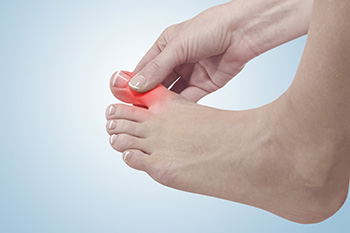Items filtered by date: January 2023
Stretching May Help to Prevent Running Injuries

It is beneficial for people who decide to take up running to learn about how to prevent running injuries. A foot or ankle that becomes injured can cause the running to temporarily stop, and this can affect the beginner or seasoned runner. There are simple methods that can be implemented that are best when practiced daily. It is important to keep the joints, ligaments, and muscles flexible, and this can be done by performing specific stretches. Having strong feet and ankles can cause an imbalance in the knees, possibly incurring a painful injury. Squats are an effective exercise to practice, in addition to lateral leg raises. The back of the leg can become stronger when calf raises are done. This is accomplished by standing on a step, and lowering the heels one at a time until a gentle stretch is felt. For more information about how to prevent running injuries, please speak with a podiatrist who can guide you toward additional stretches to perform.
All runners should take extra precaution when trying to avoid injury. If you have any concerns about your feet, contact Dr. John Branwell of Kearny, New Jersey. Our doctor will treat your foot and ankle needs.
How to Prevent Running Injuries
There are a lot of mistakes a runner can make prior to a workout that can induce injury. A lot of athletes tend to overstretch before running, instead of saving those workouts for a post-run routine. Deep lunges and hand-to-toe hamstring pulls should be performed after a workout instead of during a warmup. Another common mistake is jumping into an intense routine before your body is physically prepared for it. You should try to ease your way into long-distance running instead of forcing yourself to rush into it.
More Tips for Preventing Injury
- Incorporate Strength Training into Workouts - This will help improve the body’s overall athleticism
- Improve and Maintain Your Flexibility – Stretching everyday will help improve overall performance
- “Warm Up” Before Running and “Cool Down” Afterward – A warm up of 5-10 minutes helps get rid of lactic acid in the muscles and prevents delayed muscle soreness
- Cross-Training is Crucial
- Wear Proper Running Shoes
- Have a Formal Gait Analysis – Poor biomechanics can easily cause injury
If you have any questions, please feel free to contact our office located in Kearny, NJ . We offer the newest diagnostic and treatment technologies for all your foot care needs.
Plantar Fasciitis and the Back

Plantar fasciitis is one of the most well-known conditions that can negatively impact the feet, and it is defined as the inflammation of the plantar fascia along the arch of the foot. Most commonly, individuals discuss the symptoms in the feet that are associated with plantar fasciitis. Importantly, this includes heel pain. However, individuals with severe cases of plantar fasciitis may also experience symptoms throughout their bodies. Notably, an individual with bad plantar fasciitis may eventually begin to notice pain in the lower back area. In a related way, an individual’s hips may also begin to hurt if plantar fasciitis is left untreated for a long period. Lastly, the knees may also be negatively impacted. The lower back, hips, and knees may be adversely affected by plantar fasciitis because of the change in gait that plantar fasciitis produces. If you are someone that struggles with plantar fasciitis, contact a podiatrist today for guidance. Schedule an appointment today.
Plantar fasciitis can be very painful and inconvenient. If you are experiencing heel pain or symptoms of plantar fasciitis, contact Dr. John Branwell from Kearny, New Jersey. Our doctor can provide the care you need to keep you pain-free and on your feet.
What Is Plantar Fasciitis?
Plantar fasciitis is the inflammation of the thick band of tissue that runs along the bottom of your foot, known as the plantar fascia, and causes mild to severe heel pain.
What Causes Plantar Fasciitis?
- Excessive running
- Non-supportive shoes
- Overpronation
- Repeated stretching and tearing of the plantar fascia
How Can It Be Treated?
- Conservative measures – anti-inflammatories, ice packs, stretching exercises, physical therapy, orthotic devices
- Shockwave therapy – sound waves are sent to the affected area to facilitate healing and are usually used for chronic cases of plantar fasciitis
- Surgery – usually only used as a last resort when all else fails. The plantar fascia can be surgically detached from the heel
While very treatable, plantar fasciitis is definitely not something that should be ignored. Especially in severe cases, speaking to your doctor right away is highly recommended to avoid complications and severe heel pain. Your podiatrist can work with you to provide the appropriate treatment options tailored to your condition.
If you have any questions please feel free to contact our office located in Kearny, NJ . We offer the newest diagnostic and treatment technologies for all your foot and ankle needs.
Surgery for Big Toe Arthritis

Arthritis often strikes the joint connecting the big toe to the ball of the foot and can cause significant pain. This affliction is more common as one ages and cartilage wears away between the bones. A surgery can be performed where the bones are fused together with metal plates, but this can limit the flexibility of the toe. Another option is a type of implant that can be inserted between the bones and can cushion the aching joint. Such an implant can be as small as a miniature marshmallow. It is made of saline solution and polyvinyl alcohol, like that used in soft contact lenses. This material compresses a bit under pressure, much like real cartilage. If you suffer from arthritis in the big toe, consult with a podiatrist to see if surgery is a treatment that is right for you.
Foot surgery is sometimes necessary to treat a foot ailment. To learn more, contact Dr. John Branwell of Kearny, New Jersey. Our doctor will assist you with all of your foot and ankle needs.
When Is Surgery Necessary?
Foot and ankle surgery is generally reserved for cases in which less invasive, conservative procedures have failed to alleviate the problem. Some of the cases in which surgery may be necessary include:
- Removing foot deformities like bunions and bone spurs
- Severe arthritis that has caused bone issues
- Cosmetic reconstruction
What Types of Surgery Are There?
The type of surgery you receive will depend on the nature of the problem you have. Some of the possible surgeries include:
- Bunionectomy for painful bunions
- Surgical fusion for realignment of bones
- Neuropathy decompression surgery to treat nerve damage
Benefits of Surgery
Although surgery is usually a last resort, it can provide more complete pain relief compared to non-surgical methods and may allow you to finally resume full activity.
Surgical techniques have also become increasingly sophisticated. Techniques like endoscopic surgery allow for smaller incisions and faster recovery times.
If you have any questions please feel free to contact our office located in Kearny, NJ . We offer the newest diagnostic and treatment technologies for all your foot and ankle needs.
Reminder: When Was the Last Time...?
Healing Diabetic Foot Ulcers

Diabetic foot ulcers are difficult wounds to heal. The size of the ulcer, gender, and potential infection have been linked to healing time. Larger ulcers and infections tend to lead to longer wound closure times, and men tend to have slower healing time for wounds. One way to have a positive effect on wound healing is by making sure glucose levels are within normal range. It is particularly important for diabetics to examine their feet daily to check for cuts and scrapes that can lead to ulcers. If you have diabetes, it is suggested that you include a podiatrist on your health care team and get your feet checked regularly.
Diabetic foot care is important in preventing foot ailments such as ulcers. If you are suffering from diabetes or have any other concerns about your feet, contact Dr. John Branwell from Kearny, New Jersey. Our doctor can provide the care you need to keep you pain-free and on your feet.
Diabetic Foot Care
Diabetes affects millions of people every year. The condition can damage blood vessels in many parts of the body, especially the feet. Because of this, taking care of your feet is essential if you have diabetes, and having a podiatrist help monitor your foot health is highly recommended.
The Importance of Caring for Your Feet
- Routinely inspect your feet for bruises or sores.
- Wear socks that fit your feet comfortably.
- Wear comfortable shoes that provide adequate support.
Patients with diabetes should have their doctor monitor their blood levels, as blood sugar levels play such a huge role in diabetic care. Monitoring these levels on a regular basis is highly advised.
It is always best to inform your healthcare professional of any concerns you may have regarding your feet, especially for diabetic patients. Early treatment and routine foot examinations are keys to maintaining proper health, especially because severe complications can arise if proper treatment is not applied.
If you have any questions please feel free to contact our office located in Kearny, NJ . We offer the newest diagnostic and treatment technologies for all your foot and ankle needs.
Fun Facts About Foot Biomechanics

The feet are wonderfully complex and intricate parts of the human body. The foot is made up of a variety of bones, muscles, tendons, and ligaments that each serve a unique and important function in supporting the foot and its movement. Many individuals complain about having sweaty feet. This is explained, interestingly, by the more than 250,000 different sweat glands that are located in the feet. In just one day, the feet are capable of producing about half a pint of sweat. This fact may seem surprising, but it is nonetheless true. Additionally, another fun fact about the biomechanics of the feet is that there are more than 8,000 nerves located in the feet. As a result, the feet are particularly ticklish body parts. This large number of nerves is generally thought to be the reason for the feet being particularly ticklish. For more fun facts about the biomechanics of the feet, contact your podiatrist, a foot specialist, today.
If you have any concerns about your feet, contact Dr. John Branwell from Kearny, New Jersey. Our doctor can provide the care you need to keep you pain-free and on your feet.
Biomechanics in Podiatry
Podiatric biomechanics is a particular sector of specialty podiatry with licensed practitioners who are trained to diagnose and treat conditions affecting the foot, ankle and lower leg. Biomechanics deals with the forces that act against the body, causing an interference with the biological structures. It focuses on the movement of the ankle, the foot and the forces that interact with them.
A History of Biomechanics
- Biomechanics dates back to the BC era in Egypt where evidence of professional foot care has been recorded.
- In 1974, biomechanics gained a higher profile from the studies of Merton Root, who claimed that by changing or controlling the forces between the ankle and the foot, corrections or conditions could be implemented to gain strength and coordination in the area.
Modern technological improvements are based on past theories and therapeutic processes that provide a better understanding of podiatric concepts for biomechanics. Computers can provide accurate information about the forces and patterns of the feet and lower legs.
Understanding biomechanics of the feet can help improve and eliminate pain, stopping further stress to the foot.
If you have any questions please feel free to contact our office located in Kearny, NJ . We offer the newest diagnostic and treatment technologies for all your foot and ankle needs.

